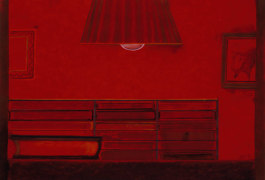
About Wood
Artschwager / Herold / McEwen
Curated by Eneas Capalbo
October 20 – December 8, 2012
Wood, as a material, is remarkable for having evaded a singular use. Applied just as readily to the construction of buildings as to the stretching of paintings, there is no proper place or use for such a versatile substance. The three artists in this show take up wood's functional ubiquity – its varied uses that pass unnoticed – and re-present it with ironic wit.
In Georg Herold's Holz Ohne Raum (No Room for Wood) (1988), a bundle of wood leans against the wall of the gallery. Herold has said that "I never use materials that speak their own language. That's why I pick on rough, stupid materials that don't ask questions." Leaning lightly against the wall of the gallery, the sculpture's physical presence is unsettling. The wood seems to have been haphazardly abandoned, its intended use unfulfilled. These bound roofing slats imply a potential structure that could be constructed, one that has been collapsed into this dense object. The title positions the space literally occupied by the work (as there is, in fact, room for the wood) against that of the architecture that the wood fails to create.
Adam McEwen's Untitled (2012) is a carbon graphite sculpture fabricated in the image of a round piece of wooden chipboard. In previous sculptures by McEwen, the artist has produced such functional objects as lightbulbs, drinking fountains, and stepping stools. These are all objects that suggest interaction – objects that are seen and touched. In this piece, however, the subject is the compressed wood used in construction, a practical material that, much like Herold's, exists behind the visible architecture. Though in opposition to Herold's idle material, McEwen presents an impostor. These sculptures are, if only visually, readymades. Yet while McEwen reproduces these common materials one to one, what he produces are surrogates. It is an uncanny duplicate – a dark image – but not the thing itself.
Richard Artscwhager's Chair (1965-2000) consists of a chair-shaped sculpture on which photographs of a wooden chair are superimposed. When asked about the origin of the work, Artschwager said that "This was the early to mid-1960s. I was making images and then making objects to support the images." The photographs, taken in 1965, did not receive their supporting structure until the sculpture's fabrication in 2000. The photographic surface is then both conceptually and temporally distanced from the depicted chair. Much like Artschwager's use of Formica – a plastic material used to give objects the appearance of wood – the photographic surface represents but does not create the well-worn wooden chair. Artschwager's domestic chair rises as a mirage on the surface, an image that retains none of the wooden tactility of the object itself.
